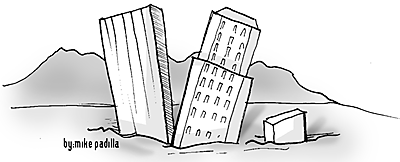
Illustration by Mike Padilla
|
|
By Dan Post
Arizona Daily Wildcat
Thursday, April 21, 2005
Print this
In case the escalating temperatures hadn't given it away, we live in a desert. Look at the ground beneath your feet. Do you see grass? What is the average daily temperature in the summer here? Can you stand outside for more than an hour when it's 105 degrees without suffering throat damage?
Has it occurred to you that maybe this place isn't optimally suited for cities with large populations? There isn't enough water for a camel, let alone a million people.
But from the way developers act, this might as well be a lush rainforest. After all, in the midst of one of the longest recorded droughts in the history of the Western United States, the population here is growing by leaps and bounds.
A report released last week by the U.S. Census Bureau showed that 164,000 people moved to Arizona from 2003 to 2004; 112,000 moved to Maricopa County and 12,000 moved to Pima County; 75,000 people moved to Clark County (covering much of Las Vegas). At the same time, the western drought reached some of its highest levels. Drought conditions will continue to persist until consecutive above-average years are recorded, even though this year's precipitation in Arizona ranks as the fourth highest year on record since 1895.
Despite the improved precipitation numbers, the summer heat combined with the huge population growth mean that water usage is still rising and groundwater levels are still falling. For this summer, residents of southern Arizona face another water crisis.
Fortunately, the city and county government are somewhat forward thinking when it comes to water use (key word: somewhat). Many places in the city practice xeriscaping (desert plant landscaping that is generally drought tolerant) and most new developments are required to do so. Additionally, the city of Tucson just hired two more water cops to police violations of the city watering codes. But there is still much to be desired in the way of water and conservation as the summer approaches.
The most obvious contradiction in local water policy concerns golf courses. Golf courses aren't going anywhere considering that they account for a huge chunk of tourist dollars coming into the city and county. But why aren't golf courses required by law to use effluent water? It is perfectly safe. Due to the city's progressive effluent technology, Tucson effluent water quality levels nearly meet the Food and Drug Administration standards for regular drinking water. And no one even drinks the water used to water a golf course. Yet, as of 2002 only 13 of the 38 courses used at least some effluent. Tucson golf courses combine to use at least 3.3 percent of total groundwater use in the city of Tucson. That number should be zero. One course, the Omni Tucson National, takes up 58 percent of local golf course water use. Now that is just absurd.
One of the reasons why many of these golf courses don't use effluent is a lack of infrastructure - there are no pipes to transport the effluent to these remote desert-mountain golf courses. Solving this problem takes a lot of money, something that the city is currently lacking. But the long term must be considered. How long, and at what cost to the future generations of Tucsonans, can these courses continue to pump groundwater for their fairways and greens? Doesn't this cost outweigh the current cost of effluent infrastructure? The golf courses and their parent corporations should be required to pay for the infrastructure needed to get effluent water themselves; they should not be permitted to mortgage the city's and its citizen's futures by pumping groundwater unnecessarily for their own private economic gain.
Another case of contradictory and illogical water policy lies right here on campus. Consider the UA, which houses the leading hydrology department in the world. The entire UA campus is covered in grass that needs regular watering and often times replanting (which requires even more water). Even though the grass is aesthetically pleasing, it is extremely wasteful. Also, the new Alumni Plaza's fountains have granite faces that point south and receive significantly more sunlight than objects facing north; this makes for a lot of evaporation and refilling of the fountains. There is no doubt we can do a better job conserving water on campus - it would have been a simple design choice to flip those fountains around to face north so they wouldn't waste as much water.
We can conserve in individual ways too. Take shorter showers, don't let the faucet run when doing your dishes, and maybe, just maybe, we'll make it out of this drought alive.
But now I'm just spouting off ideas, of which there are many. Wouldn't it be nice if more of them were actually used?
Dan Post is an ecology and anthropology senior. He can be reached at letters@wildcat.arizona.edu.
